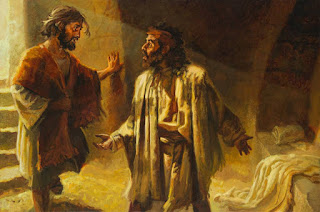THE LIVES OF THE PATRIARCHS #105 | THE LIFE OF MOSES #87
Pastor Christopher Choo
Lesson 3789
THE LIVES OF THE PATRIARCHS #105
THE LIFE OF MOSES #87
Lesson from the Red Sea Crossing #9
THE MYSTERY OF THE FOLDED NAPKIN IN THE TOMB OF JESUS.
One of the highlights of our tours of Israel is undoubtedly the Garden Tomb in Jerusalem.
The Garden Tomb is a rock-cut tomb in Jerusalem unearthed in 1867 and considered by some to be the site of the burial and resurrection of Jesus.
Our tour members are only too excited to have their Samsung/ Huawei moments recorded when they go in and out of this tomb. Snap, snap...
But there is a controversial detail mentioned in John's gospel that is often overlooked and left forgotten.
Why did Jesus fold the linen burial cloth after His resurrection?
The Gospel of John (20:7) tells us that the napkin, which was placed over the face of Jesus, was not just thrown aside like the other grave clothes.
The Bible takes an entire verse to tell us that the napkin was neatly folded, and was placed at the head of that stony tomb.
Early Sunday morning, while it was still dark, Mary Magdalene came to the tomb and found that the stone had been rolled away from the entrance.
She ran and found Simon Peter and the other disciple, the one whom Jesus loved. She said, “They have taken the Lord's body out of the tomb, and I don't know where they have put him!” Peter and the other disciple ran to the tomb to see. The other disciple outran Peter and got there first. He stooped and looked in and saw the linen cloth lying there, but he didn't go in.
Then Simon Peter arrived and went inside. He also noticed the linen wrappings lying there, while the cloth that had covered Jesus' head was folded up and lying to the side.
In order to understand the significance of the folded napkin, we need to understand a little bit about Hebrew tradition of that day.
The folded napkin had to do with the master and servant, and every Jewish boy knew this tradition. When the servant set the dinner table for the master, he made sure that it was exactly the way the master wanted it. The table was furnished perfectly, and then the servant would wait, just out of sight, until the master had finished eating.
The servant would not dare touch the table until the master was finished. Now if the master was finished eating, he would rise from the table, wipe his fingers and mouth, clean his beard, and wad up the napkin and toss it onto the table. The servant would then know to clear the table. For in those days, the wadded-up napkin meant, “I’m finished.”
But if the master got up from the table, folded his napkin, and laid it beside his plate, the servant would not dare touch the table, because the folded napkin meant, “I'm coming back!”
Let us be reminded daily during this post-Easter season, Jesus Christ is “Not Finished.” He is coming back for his faithful servants within his Church.
N.B. This view remains controversial as it has not been accepted in mainstream churches. Suffice to say it is an attempt to unravel the mystery of the folded napkin.






